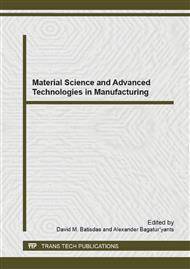p.432
p.437
p.441
p.447
p.452
p.457
p.463
p.467
p.472
Comparison of the Bearing Capacity of Dry and Wet Cutting Surfaces
Abstract:
The performance of high strength steels is sensitive to the surface quality of machined surfaces. The effect of cutting condition on the variation of surface roughness in turning of 30CrMnSiA steel has been investigated through a serial of dry and oil-lubricant cutting tests. The characters of an amplitude characteristics set, Ra, Ry and tp, which are associated with the general shape of the machined surface profiles, are investigated in this study. It is concluded that, in the aspect of Ra and Ry values, dry cutting condition provides a similar surface roughness as in wet cutting condition under the experimental conditions of the present research; the bearing capacity of both kinds of machined surfaces, characterized by the bearing length rate tp, could be different according to the cutting parameters combinations.
Info:
Periodical:
Pages:
452-456
Citation:
Online since:
January 2014
Authors:
Price:
Сopyright:
© 2014 Trans Tech Publications Ltd. All Rights Reserved
Share:
Citation:


